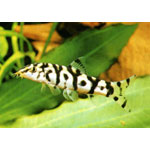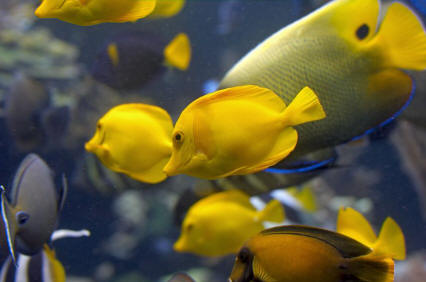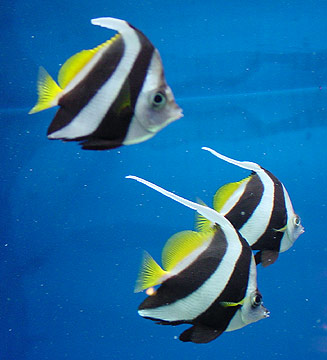Pakistani Botia

|
Scientific Name: Botia lohachata Price: Upon Request Origin: Asia: Pakistan, India, Bangladesh and Nepal Family: Cobitidae NOT AVAILABLE NOW |
|
Other Names: Yoyo loach, Yo-Yo Loach, Pakistani loach, Botia almorhae, Almorha Loach, Reticulated loach, Botia dayi, Botia grandis, Botia rostrata |
|
Technical Info
Temperature: 24 - 30 ℃
pH: 6.5 - 7
GH: 5 - 10
Max size: 10 cm
Min Tank size: 100 Ltr
Position in Aqua: Bottom swimmer
Description
Pakistani Botia grows to a maximum of 10 cm in length and, funnily enough, has a pattern of “Y’s” and “O’s” along its flanks. This species has a sliver-gold, scaleless body. It can be difficult to sex this species, but males are usually slimmer and may display a red colouration around their barbells. The Pakistani Botia has a downward-pointing mouth and four pairs of barbels protruding from its mouth.
Food
Good quality flake, sinking pellets, algae wafers, chopped earthworms, thawed frozen Bloodworm, Mysis Shrimp, chopped cocktail shrimp. Avoid over-feeding as these fish are very greedy. This species is an avid consumer of snails.
Breeding
This species has not been bred in captivity and, as such, not a lot of information is available on its breeding requirements. It is an egg laying species, however, and there have been reports of female Pakistani Botias carrying eggs. It appears to be a very difficult species to breed.
Compatible with
You might consider housing this species many of the Tetra species (particularly the Neon Tetra and Black Tetra). They are also great tank mates with Discus, Apistogramma‘s like Apistogramma Cacatouides and Apistogramma Borelli, Corydoras Catfish (particularly Corydoras Sterbai and Corydoras aeneus) Angelfish, Clown loach, the common Guppy and Platy and most Gourami (such as the Blue Gouramiand Dwarf Gourami like the Honey Gourami). Also can live happily with most Danio (particularly the Zebra Danio and Pearl Danio) and also many Killifish make great tank mates.
Note
These fish can be a great addition, or a terrible inclusion to a tank. They can be very active, chasing each other around the tank at high speed, and terrorizing other members of the community. They must be kept in groups of at least 4-5 to ensure that they keep any aggressive behaviour amongst themselves.

